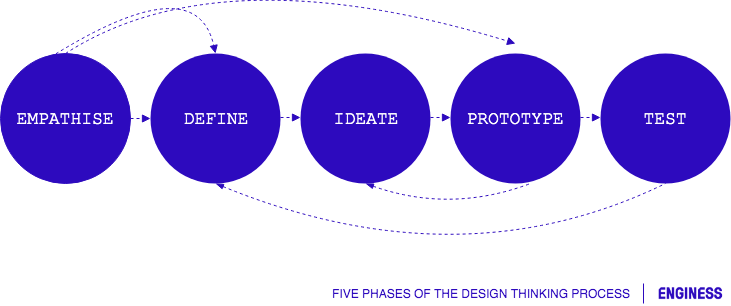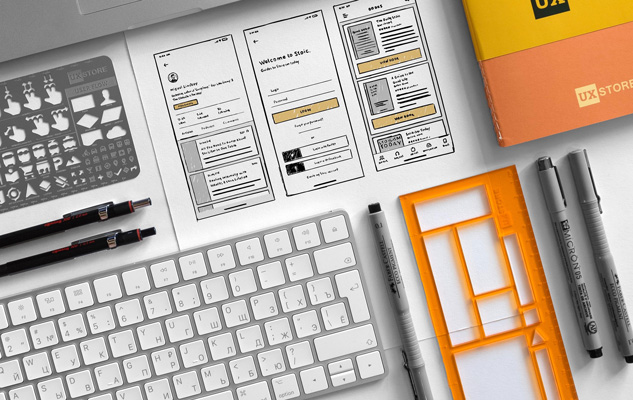Design Thinking and Data
Data and Design Thinking: Why Use Data in the Design Process?
Design thinking combined with data science and analytics, can help organizations unlock new opportunities and reinforce long-term innovation capability.
Data and business go together like two peas. However, design and business? That’s a little less intuitive. Today, we’re going to take a closer look at design thinking, how to use data in design, and what data matters.
What is Design Thinking?
Let’s start with a definition. Design thinking, according to IDEO’s CEO Tim Brown, is:
“a human-centred approach to innovation that draws from the designer’s toolkit to integrate the needs of people, the possibilities of technology, and the requirements for business success.”
Let’s break that down a little. Design thinking is:
- Human-centered: you have to put people at the heart of your design
- Approach to innovation: it’s a methodology and set of guiding rules
- Designer’s toolkit: all the tools, tips, and tricks that designers use to bring ideas and concepts to market.
- Integrate people, technology, and business: it has to bring together the end user (people) using the technology that exists now / in the near future, and design must do this while meeting business requirements.
With all that in mind, we define design thinking as:
A specific methodology/approach for designing new products, services, and experiences that put the user at the heart of the process, using every trick in the book to tie together the user and technology while achieving business requirements.
Design thinking is about taking the approach a designer would — focusing on the user, incorporating technology, considering the intersection of feasibility, desirability, and viability — outside of a design context. This means tinkering and playing with an idea, reviewing and failing all the time, and listening to the people, you’re designing for and staying laser-focused on their needs.
Design Thinking Process
So that’s the ethos behind design thinking. Next, we need to understand how it’s actually done. The process could vary depending on what model you consult, but design thinking generally fits into this framework.
- Empathize. Work to understand your audience - who your audience is, what are their pains, problems, attitudes, and what they want to accomplish at an emotional level beyond your product.
- Define. Define the problem that you’re going to solve in the context of the pains and challenges you uncovered in your empathy discovery. This leads to a problem/challenge statement.
- Ideate. Come up with a bunch of different ways to solve the problem.
- Prototype. Turn those ideas into the lowest possible fidelity test that you can execute and still get clean data. This stage usually cuts the ideas down as problems are discovered.
- Test. Get your prototypes in front of users and see what they say.

Why Business are Embracing Design Thinking
Over the last 20 years, companies have become far, far more customer-centric. For instance, it’s hard to imagine a sales team being run today like in Glengarry Glen Ross. Sales are a consultative process now. Products are built with countless revisions of UX testing baked directly into the process.
For sure, every now and again, a Steve Jobs visionary comes and shifts the paradigm of innovation. However, overwhelmingly, organizations are currently in the business of intimately knowing their customers and building and selling things their customers want.
Also, let’s be honest — knowing your customer isn’t a new idea. Organizations have always tried their best to understand who’s buying them and create products that their customers would also like.
Design thinking, with its customer centricity, is a natural fit in the new business paradigm.
Why Use Data in the Design Process?
To recap, design thinking is thinking like a designer, putting your customer/user first, and solving non-design problems with a design toolkit and methodology.
Now, to data.
The emergence of the internet and subsequent massive data collection and storage mean that now, businesses can know their customers better than they ever thought possible. This drives up product quality, in turn driving up customer expectation in a vicious feedback loop.
Now, organizations are expected to know and anticipate user needs at an individual level.
Moreover, you can’t deliver that quality with design thinking alone.
 Data, especially big data about your users’ actual behaviour, can help you understand where you need to focus, how users are using your product/service “in the wild”, and exactly what pieces are driving people to love your organization.
Data, especially big data about your users’ actual behaviour, can help you understand where you need to focus, how users are using your product/service “in the wild”, and exactly what pieces are driving people to love your organization.
The extreme example of this sort of data-ization is product-led growth (PLG), where the product is so focused and attuned to solving users’ problems that it literally sells itself.
However, even if you’re not a VC-backed PLG machine like Slack or Dropbox, you can still use data to understand your customers’ pains better, and fuel design-thinking-led product development.
What Data Should I Use?
One of the dangers of having access to data on literally everything is that separating the signal from the noise is incredibly difficult. Your data evaluation will be idiosyncratic to your organization. Fortunately, there are a few must-haves that will likely apply to everyone.
Website analytics
The most accessible source of insights for almost any organization is its website. It’s a treasure-trove of data, but it does have to be parsed correctly. For a design thinking approach, we recommend looking at:
- Your user flows. What are people looking at, and where are they going?
- See where / what people look at with heat mappings and automatic screen recordings. Content analytics and SERP position. Are you talking about the right stuff? Are you answering the questions people are asking, and does your product solve the problems that they’re looking for solutions to?
App analytics
In-app analytics do serve a similar function to website analytics but differ slightly due to their more practical nature. That is, people go to your website for all sorts of reasons. An e-commerce site, for example, might have traffic both from users looking to buy and people looking for a job.
App analytics are cleaner and speak more to what users are looking for. In particular, app analytics can be used especially effectively to both empathize with your audience, define your problem (if you’re working on the app itself), and test via A/B testing (more on this in a second).
A/B and multi-variate testing
A/B and multi-variant testing, it’s a more adult cousin, are probably the easiest way to test ideas in a design thinking setting. Because of that, they can be used, of course, in testing, but also throughout the process:
- Empathy and problem definition can be tested with A/B testing messaging.
- Ideas can be rapidly prototyped with multi-variant testing on an app or a website.
Behaviour flows and other UX testing
UX has a lot of other mechanisms to offer beyond A/B testing. There are a few of these in particular that are helpful for design thinkers in business.
First, behaviour flows on your site or app. Where are users going and how they’re getting there can tell you a huge amount about what they’re thinking, what they like/don’t like, and what they struggle with.
Second, paper prototyping. Paper prototyping in the context of an app or a piece of software is basically a paper version of whatever you’re going to design. It’s incredibly fast and easy to make, meaning that you can test a huge amount, very very quickly without wasting development hours.

Third, in-person UX testing. Sitting down with someone to talk them through an idea, interview them about the problem, or just talk through a solution is tremendously valuable because it gives you first-hand insight, straight from the horse's mouth.
Finally, online user testing. Usertesting.com is the most popular, but there are plenty of sites out there that will give you the ability to rapidly test your idea in the hands of the exact people you’re trying to help.
Conclusion
Design thinking doesn’t have to be something that only creative agencies use. Anyone can use the framework to drive business objectives.
Understanding your customer, their pains, and iterating to solve them is always going to be a sound business strategy. And by overlaying the method with hard data, you can drive more meaningful insights, faster and more effectively than ever before.
So what’s your next step? Are you ready to embrace design thinking and achieve your growth goals?
